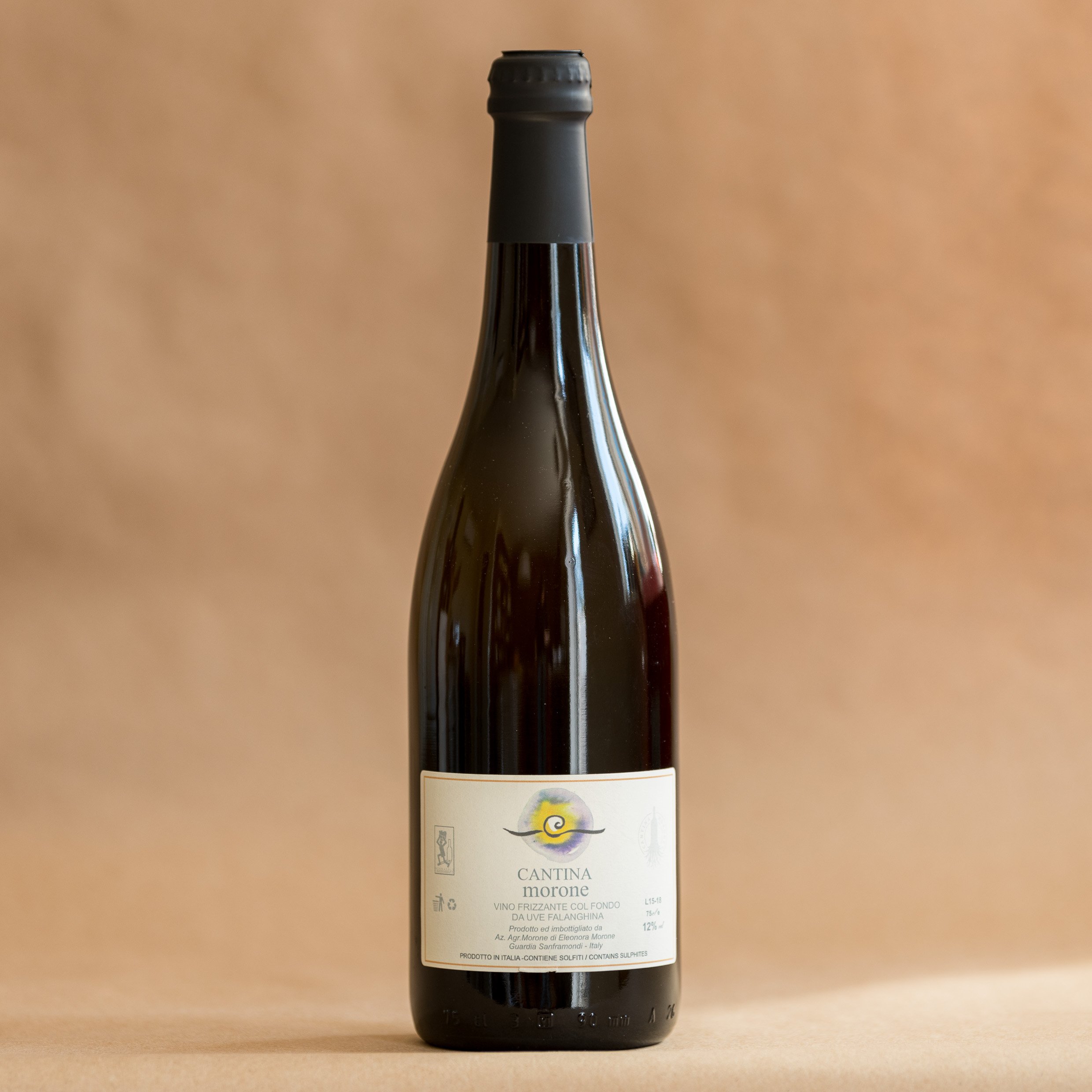


























Cantina Morone
Who: Giovanni & Eleonora Morone
Where: Guardia Sanframondi (Campania, Italy)
What grapes: Falanghina, Piedirosso, Fiano, Sangiovese
Key facts: This certified-organic family farm is run by siblings with a dedication to indigenous grapes of their inland Campania home.
Website: http://www.morone.it
Instagram: @cantina_morone
Cantina Morone “Monaci” Benevento Falanghina IGP
Viticulture: Certified Organic
Soil type: Terra Bianca limestone-rich clay soils
Elevation: 250m
Grapes: Falanghina from a single vineyard (Monaci) once owned by Franciscan Monks who produced wine for Mass
Method of fermentation: Harvested by hand in the cool early morning followed by a soft pressing and fermentation using natural yeast in stainless steel. Grapes and wine moved by gravity, kept under a blanket of inert gas and crushed in a closed press to minimize oxidation.
Bottles made: 4,000
2020 Monaci Falanghina IGP Benevento seems more mineral than in the past. Apple is still in the foreground. I like this wine because it avoids the tropical excesses of some overripe Falanghina. Mellow, balanced, satisfying. Medium weight, a must-try for fans of Macon-villages, or Rhone white drinkers who need a little more spice in their life. Monaci wants you to cook a chicken. We’ll both wait. — JM
Cantina Morone “Albanora” Falanghina del Sannio DOP
Viticulture: Certified Organic
Soil type: Terra Bianca limestone-rich clay soils
Elevation: 250m
Grapes: Falanghina from a single old vineyard (Acquefredde) with sparse bunches and low productivity which make this vineyard a "unique" site.
Method of fermentation: Harvested by hand in the cool early morning followed by a soft pressing and fermentation using natural yeast in stainless steel. Grapes and wine moved by gravity, kept under a blanket of inert gas and crushed in a closed press to minimize oxidation
Bottles made: 5,000
2020 Albanora Falanghina DOP is darker in color than the Monaci. Albanora is a vineyard with 40-50 year-old vines. Lower yielding, more concentrated, a better biotype than modern clones of Falanghina. Great flavor, sparse fruit though, hence it fell out of favor during the bulk/co-op phase of this area’s viticultural history (a phase that hasn’t really fully ended.) Albanora has a lovely tobacco leaf aroma. Bitter almond, a touch waxy. I want this with a white pizza topped with clams, and smoked mozz. — JM
Cantina Morone “Fiori di Galano” Sannio Piedirosso DOP
Viticulture: Certified Organic
Soil type: Terra Bianca limestone-rich clay soils
Elevation: 250m
Grapes: Piedirosso from a single vineyard (Galano)
Method of fermentation: Harvested by hand in the cool early morning followed by a soft pressing. 15-25 day fermentation using natural yeast in stainless steel. Grapes and wine moved by gravity, kept under a blanket of inert gas and crushed in a closed press to minimize oxidation. Aged partially in wood and partially in steel.
Bottles made: 3,384 bottles, all numbered by hand.
The 2019 Piedirosso smells ripe, like a prettier cousin to Carignan. Dark color, nice open mid-palate, perfect for spaghetti with marinara and abundant red pepper flakes, or spiedini. — JM
Cantina Morone Vino Frizzante col fondo
Viticulture: Certified Organic
Soil type: Terra Bianca limestone-rich clay soils
Elevation: 250m
Grapes: Falanghina
Method of fermentation: Harvested by hand in the cool early morning followed by a soft pressing. Secondary Fermentation in bottle. Unfiltered.
The 2020 col fondo from Cantina Morone is dry and clean: precise in its flavors. Citrus. Unfiltered. I definitely want spicy stuffed squid with this one, or simple fried calamari and lemon. Kudos to our small team of col fondo-making estates, who seem to capture the wild appeal of this style of fizz, while avoiding its funky pitfalls. — JM
Cantina Morone “Camarosa” Benevento Rosato IGP
Viticulture: Certified Organic
Soil type: Terra Bianca limestone-rich clay soils with volcanic debris
Elevation: 150m above sea level
Grapes: Camaiola Hand picked during the third week of September into 20kg baskets. Guyot trained. 4,400 plants/hectare.
Method of fermentation: Two day maceration on the skins. Fermented in stainless steel. Aged in stainless steel for six months, followed by three months of bottle aging.
Bottles made: 2,500
“The red grape this wine is made from is now called Camaiola. It used to be Barbera del Sannio, a confusing name given the absence of any genetic link to Barbera from northern Italy, and the completely distinct flavor and appearance of Camaiola’s berries. This is autumnal rosato. Think Cerasuolo d’Abruzzo, or Ciliegiolo. Oenologist Anna della Porta preserves the macerated red berry aromas of this wine by moving the hand-picked fruit gently via gravity into the cellar, keeping it under a blanket of inert gas to prevent oxidation, and fermenting the wine in temperature controlled tanks, with minimal sulfur additions. I’d love it with Mortadella panini, an olive salad, and maybe the season’s last ripe small tomatoes.” — JM
Wine name
Viticulture: Certified Organic
Soil type: Calcareous clay soil
Elevation: 50-250m above sea level
Grapes: 65% Sangiovese, 25% Piedirosso, 15% Barbera del Sannio, Guyot trained. 3,400 plants per hectare.
Method of fermentation: Hand picked into small baskets. Sangiovese and Barbera del Sannio (Camaiola) are picked in September, Piedirosso during the third week of October. Moved via gravity under inert gas into the cellar. Fermented in stainless steel. Sangiovese is aged in old wood barrels, the other two varieties are aged in stainless steel. After six months the wine is blended together in concrete tank, and aged for an additional three months in bottle.
Whatever level of southern hospitality exists in the ancient Apennine mountain towns of your imagination, real life septuagenarian farmers Pasquale and Maria Morone exceed it. The matriarch/patriarch of Cantina Morone are beyond generous with their time and their talents. Their adult children Giovanni and Eleonora have transformed this estate, lowering yields, ditching chemicals, estate-bottling. Because of the younger generation’s vision, the fruit Pasquale harvests will become exciting organic wine worth importing to America. But that new high level of quality is rooted in the energy, diligence, fastidiousness, and above all the heart and kindness of Pasquale and Maria. They set the culture, and the path.
Maria has turned the apartment behind their home and cellar into a beautiful agriturismo. The food she creates in the cantina’s commercial kitchen is revelatory, delicious, and above all things abundant. “Zero kilometer meal.” Pasquale boasts. “Less than zero kilometers!” The couple’s fidelity to local foods is admirable. From the grain for the bread Paolo bakes daily, to the pork stuffed inside it, the raw materials at Cantina Morone are 100% of Campania, of Guardia. Maria claims the heirloom beans they cook won’t give you a bubbly belly. A bold statement, but maybe she’s right? A sample size of three diners consuming one meal (with a side of pizza) was too small to be sure. Fresh tagliatelle was topped with locally-foraged porcini. Even the post-dinner digestivo Strega is from nearby Benevento. It’s one of my favorites: the radiant yellow, the no-nonsense abv, the improbable bottle shape, the name! Strega means witch.
On the morning after our arrival, Pasquale took us for a walk through the winding narrow stone streets of Guardia Sanframondi. Past idle dogs and men, under centuries-old archways whose beams looked weathered, exhausted, to a breathtaking precipice/overlook. A vista across the valley which seems entirely blanketed in vines, to more mountains, with peaks shrouded in clouds. In the foreground, the town's former monastery was being restored. It has been converted (by Americans) into a yoga center.
Pasquale can’t contain his pride when discussing Guardia Sanframondi and the surrounding fertile, mountainous region. We popped into a local municipal building to see frescoes painted by local artist Paolo de Matteis in the early 18th century. Saints in the clouds, cherubs holding bouquets of flowers and feather pens, that kind of thing. Angels with swords. A baby nursing from the breast of a pallid corpse. So, yeah. Outside we passed crumbling houses for sale, centuries-old storefront churches, tiny appealing/sinister subterranean residences, buildings clinging to the cliffside, stacked at every conceivable angle. Succulents growing from mortared facades. Through the maze we wound our way to Cantina Morone’s original cellar. Pasquale remembers his mother making wine in the abandoned space. He’d love to renovate it. Today it remains locked, barrels and fermentation equipment buried under a thick layer of dust. The irregular bone-white arched walls of the cellar hide behind a low door that opens via a giant rusted skeleton key. It’s an eerie space. I feel the past pressing on my chest while we’re in it. The silence underground, the casual clutter, as though Pasquale’s predecessors left at the end of a normal workday and never returned. Just outside the cellar, a massive keep rises out of a sheer stone cliff face. A 30-meter-tall otherworldly monolith. Impregnable.
Back at the new cantina, Eleonora Morone joins us for a tasting of the estate’s wines. Made with the help of consulting oenologist and childhood friend Anna della Porta, the current line-up (arriving in December) puts my mind at ease. It has been too long since we had bottles from this beautiful green corner of Campania in stock. Eleonora is the administrative heart of the winery, and shares the irrepressibly kind demeanor of her parents. It’s a joy to meet with Eleonora. Over the course of a couple hours we tasted through kinda everything, both in bottle (2020s) and tank (2021s.) I’ll limit my notes to the soon-to-arrive wines, though from this session it’s fair to say others may merit importation soon.
2020 Monaci Falanghina IGP Benevento seems more mineral than in the past. Apple is still in the foreground. I like this wine because it avoids the tropical excesses of some overripe Falanghina. Mellow, balanced, satisfying. Medium weight, a must-try for fans of Macon-villages, or Rhone white drinkers who need a little more spice in their life. Monaci wants you to cook a chicken. We’ll both wait.
2020 Albanora Falanghina DOP is darker in color than the Monaci. Albanora is a vineyard with 40-50 year-old vines. Lower yielding, more concentrated, a better biotype than modern clones of Falanghina. Great flavor, sparse fruit though, hence it fell out of favor during the bulk/co-op phase of this area’s viticultural history (a phase that hasn’t really fully ended.) Albanora has a lovely tobacco leaf aroma. Bitter almond, a touch waxy. I want this with a white pizza topped with clams, and smoked mozz.
The 2020 col fondo from Cantina Morone is dry and clean: precise in its flavors. Citrus. Unfiltered. I definitely want spicy stuffed squid with this one, or simple fried calamari and lemon. Kudos to our small team of col fondo-making estates, who seem to capture the wild appeal of this style of fizz, while avoiding its funky pitfalls.
The 2019 Piedirosso smells ripe, like a prettier cousin to Carignan. Dark color, nice open mid-palate, perfect for spaghetti with marinara and abundant red pepper flakes, or spiedini.
After time in the tank room, Eleonora returned to her kids/normal life and we retired to the agriturismo’s small kitchen to taste samples Jeff and Amy had collected while traveling from Rome to Matera to the Amalfi coast. There were some winners. Pasquale intermittently checked our progress, marveled at the amount of wine we were wasting (it can’t go home with us, suitcases are only so big) and provided snacks. I felt optimism about our work. The needle-in-a-haystack methodology was yielding some real finds. I still feel excitement when something new-to-us is unearthed. The wine world is still more unknown than known.
I have been only three times, but, I feel deeply attached to the province of Benevento, Sannio, Guardia Sanframondi, and the people of Cantina Morone. The place is aesthetically appealing without being a pastiche of southern Italy, or a tourist cliché. The food is unparalleled (undeniably the best pizza in Italy, also mind-bendingly good mozzarella di bufala) and the wines are underappreciated. I think the quality work being done in vineyards around Sannio will transform the place over the next decade or two. I hope farmers benefit, and that the region sees prosperity without too much change in its character. I hope it remains.






